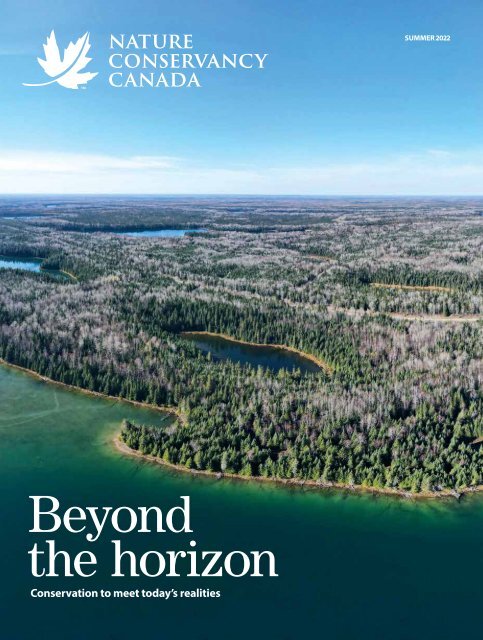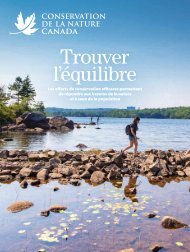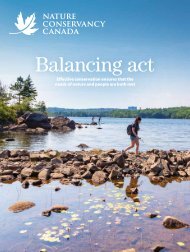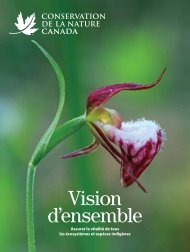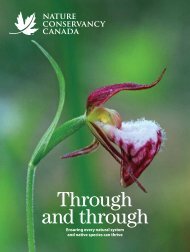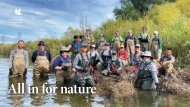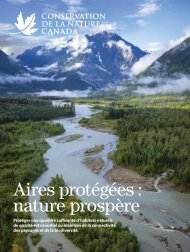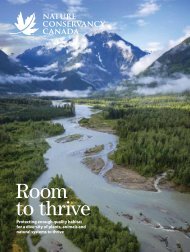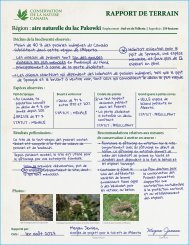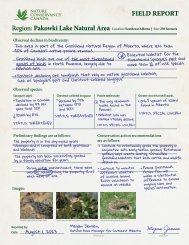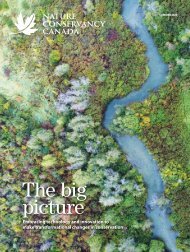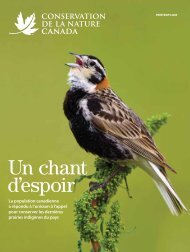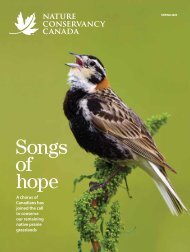NCC Magazine - Summer 2022
You also want an ePaper? Increase the reach of your titles
YUMPU automatically turns print PDFs into web optimized ePapers that Google loves.
SUMMER <strong>2022</strong><br />
Beyond<br />
TKTKTKTKTKTKT<br />
the horizon<br />
Conservation to meet today’s realities<br />
natureconservancy.ca<br />
WINTER 2021 1
SUMMER <strong>2022</strong><br />
CONTENTS<br />
Nature Conservancy of Canada<br />
4 Accelerating conservation at new scales<br />
Doubling the pace of our conservation impact.<br />
6 Dr. Bill Freedman Nature Reserve<br />
This nature reserve outside Halifax commemorates a long-term <strong>NCC</strong> volunteer.<br />
7 Share your nature pics<br />
The Big Backyard BioBlitz is back!<br />
7 Connect and recharge<br />
Minister of Environment and Climate Change, Steven Guilbeault,<br />
describes how nature revives him.<br />
8 Big, bold and impactful<br />
Expanding the pace, scale and scope of conservation.<br />
12 North American river otter<br />
Nature’s water clowns are making a comeback.<br />
14 Force for nature<br />
<strong>NCC</strong> board member Rob Prosper sees the potential to accelerate conservation<br />
through Indigenous-led protected areas.<br />
16 Project updates<br />
Investing in our future, MB; Keep The Rock Rugged, NL; a legacy of care, AB.<br />
18 A love letter to the mountains<br />
How the mountains changed one woman’s life.<br />
Digital extras<br />
Check out our online magazine page with<br />
additional content to supplement this issue,<br />
at nccmagazine.ca.<br />
Nature Conservancy of Canada<br />
245 Eglinton Ave. East, Suite 410 | Toronto, Ontario, Canada M4P 3J1<br />
magazine@natureconservancy.ca | Phone: 416.932.3202 | Toll-free: 877.231.3552<br />
The Nature Conservancy of Canada (<strong>NCC</strong>) is the country’s unifying force for nature. We seek solutions to the<br />
twin crises of rapid biodiversity loss and climate change through large-scale, permanent land conservation.<br />
<strong>NCC</strong> is a registered charity. With nature, we build a thriving world.<br />
The Nature Conservancy of Canada <strong>Magazine</strong> is distributed to donors and supporters of <strong>NCC</strong>.<br />
TM<br />
Trademarks owned by the Nature Conservancy of Canada.<br />
FSC is not responsible for any calculations on<br />
saving resources by choosing this paper.<br />
Printed on Enviro100 paper, which contains 100% post-consumer fibre, is EcoLogo, Processed Chlorine Free<br />
certified and manufactured in Canada by Rolland using biogas energy. Printed in Canada with vegetablebased<br />
inks by Warrens Waterless Printing. This publication saved 156 trees and 51,445 litres of water*.<br />
TKTKTKTKTKTKT<br />
GENERATED BY: CALCULATEUR.ROLLANDINC.COM. PHOTO: JON FELDGAJER. COVER: ANDREW WARREN.<br />
*<br />
natureconservancy.ca
Keep The Rock Rugged<br />
Big, bold and boreal<br />
Featured<br />
Contributors<br />
TKTKTKTKTKTKT<br />
TOP TO BOTTOM: GENEVIÈVE LESIEUR; ANDREW WARREN; NIV SHIMSHON.<br />
It has been a busy time here at the Nature Conservancy<br />
of Canada (<strong>NCC</strong>), with so much great work underway to<br />
accelerate conservation across the country. There are many<br />
exciting successes to celebrate, but one that stands out to me<br />
from recent months is a project we’ve nicknamed “big, bold and<br />
boreal.” This Earth Day, I was delighted to join colleagues and<br />
partners to launch our Boreal Wildlands project.<br />
It’s certainly big, and bold: it’s the largest project the Nature<br />
Conservancy of Canada (<strong>NCC</strong>) has undertaken, and the biggest<br />
private land conservation project ever in this country. And it’s<br />
boreal, spanning nearly 1,500 square kilometres in Ontario’s<br />
boreal forest — part of the largest forest system on the planet.<br />
In this issue, you’ll read about why landscape-scale protected<br />
areas are crucial if we are to tackle the global challenges of<br />
climate change and biodiversity loss. Working from coast to<br />
coast to coast, <strong>NCC</strong> aims to double the pace of conservation<br />
in the next few years. In the face of these challenges, nature<br />
offers us real solutions. That is why we are working at an<br />
unprecedented pace now to conserve the natural areas that<br />
are our life support systems.<br />
Just as nature offers us solutions to the world’s most pressing<br />
issues, collaboration is the key to getting more nature into our<br />
lives. The Boreal Wildlands is a $46-million project. With the<br />
support of our partners, as well as individual donors and foundations,<br />
we have raised more than two-thirds of the funds. This<br />
spring, we launched a fundraising campaign to close the project.<br />
We need you! To learn more about how you can support the<br />
Boreal Wildlands, or other projects, visit borealwildlands.ca.<br />
Thank you as always for your support,<br />
Catherine Grenier<br />
Catherine Grenier<br />
President and CEO, Nature Conservancy of Canada<br />
Brian Banks is a writer,<br />
editor, geographer and<br />
perpetually aspiring<br />
naturalist devoted to<br />
experiencing and<br />
advocating for the<br />
animals and plants with<br />
whom we co-exist and<br />
the environment on<br />
which we depend.<br />
Jacqui Oakley has<br />
illustrated for The New<br />
York Times, Reebok,<br />
Rolling Stone and<br />
National Geographic<br />
with her art shown in<br />
Toronto, L.A. and<br />
Shanghai. After living in<br />
Zambia, Bahrain and<br />
England, she now lives<br />
in Hamilton, Ontario.<br />
natureconservancy.ca<br />
SUMMER <strong>2022</strong> 3
COAST TO<br />
COAST<br />
Vidal Bay, ON<br />
Accelerating<br />
conservation<br />
at new scales<br />
In the face of climate change and biodiversity loss, the<br />
Nature Conservancy of Canada is conserving more, faster<br />
T<br />
he Nature Conservancy of Canada (<strong>NCC</strong>) is working at an<br />
unprecedented scale to deliver conservation impact. As the<br />
largest private land conservation organization in the country,<br />
<strong>NCC</strong> is unlocking solutions to support Canada’s targets to conserve<br />
30 per cent of our lands and waters by 2030.<br />
Accelerating conservation means <strong>NCC</strong> is delivering conservation<br />
impact faster and more extensively than ever before. We’re not only<br />
putting our energy and ambition into privately protected and conserved<br />
areas, we’re helping others contribute toward Canada’s 30 by 30 goal<br />
and lending our expertise in conserving lands of high natural value.<br />
We can’t do this alone, and we are committed to collaboration,<br />
consultation and bringing people together for change.<br />
HELPING NATURE CONTINUE TO SUPPORT LIFE<br />
When habitats are integrated and connected, and entire natural systems<br />
are conserved, nature can better deliver essential services that support<br />
life. By connecting landscapes that provide nature-based solutions, we’re<br />
taking care of places that clean our water, purify our air, absorb and<br />
store carbon, and support food security. Protecting connected habitat<br />
also supports the species that live there, including close to one-third<br />
of Canada’s species at risk.<br />
Learn more about the projects<br />
that are helping accelerate<br />
conservation in Canada and<br />
how you can help<br />
natureconservancy.ca/<br />
accelerate.<br />
ANDREW WARREN.<br />
4 SUMMER <strong>2022</strong> natureconservancy.ca
PROJECTS THAT ARE MAKING A DIFFERENCE<br />
How do we do it? Through projects large and small, and through partnerships such as the Government of Canada’s Natural Heritage Conservation Program,<br />
across the country. Here are some of the projects undertaken over the past two years that have added to our conservation impact.<br />
Qat'muk, BC<br />
<strong>NCC</strong> was invited to help deliver the complete and<br />
permanent extinguishment of all tenures and development<br />
rights in the Jumbo Valley, and to support the Ktunaxa<br />
Nation Council (KNC) in their ongoing conservation planning<br />
for the establishment of an Indigenous Protected and<br />
Conserved Area. <strong>NCC</strong> is honoured to work with the KNC to<br />
help them achieve their vision of fully protecting Qat'muk.<br />
Thaidene Nëné, NWT<br />
Sometimes, the smallest projects<br />
carry the biggest impact. Within a vast<br />
area of cultural and ecological significance,<br />
<strong>NCC</strong> purchased a private holding<br />
of about one hectare, transferring it to<br />
Parks Canada. This removed an obstacle<br />
to completing Thaidene Nëné National<br />
Park Reserve, influencing the conservation<br />
of over 14,000 square kilometres in<br />
keeping with the wishes of local<br />
Indigenous communities.<br />
Buffalo Pound, SK<br />
You helped us conserve the seven<br />
kilometres of shoreline around<br />
Buffalo Pound Lake for the sake of<br />
threatened grasslands and species<br />
at risk. This natural area provides<br />
drinking water for 25 per cent of the<br />
province’s population.<br />
TOP TO BOTTOM: PAT MORROW; PARKS CANADA; <strong>NCC</strong>; JASON BANTLE; MIKE DEMBECK; MIKE DEMBECK.<br />
Vidal Bay, ON<br />
The project comprises more than 7,600 hectares of shoreline and forest, redefining<br />
landscape-scale conservation in southern Ontario. The forests, wetlands and alvars found<br />
here capture and store nearly 23,000 tonnes of carbon dioxide a year; the equivalent of<br />
taking nearly 5,000 cars off the road annually.<br />
Chignecto<br />
Isthmus, NS/NB<br />
The Chignecto Isthmus is the<br />
narrow strip of land connecting<br />
mainland Nova Scotia to New<br />
Brunswick and the rest of North<br />
America. Since 2010, you have<br />
helped us conserve just over<br />
2,200 hectares on both sides<br />
of the border, continuing to<br />
steward and expand upon our<br />
existing conservation efforts<br />
along this critical wildlife corridor.<br />
Krieg Property, QC<br />
The Krieg property in the Green Mountains Nature Reserve<br />
is an idyllic natural area full of life. Its mature forests are home<br />
to eastern wood-pewee, a small, threatened songbird. Several<br />
species of spring salamanders also live in the area’s streams.<br />
<strong>NCC</strong> hopes to connect the property to the Green Mountains<br />
Nature Reserve, a place of high biodiversity and a well-used<br />
outdoor recreation area in Quebec.<br />
Upper Ohio, NS<br />
The conservation of rare Acadian<br />
forest, over 25 kilometres of lake<br />
shoreline and 130 hectares of freshwater<br />
wetlands in Upper Ohio make this<br />
project the third-largest acquisition in<br />
<strong>NCC</strong>’s 50-year history in the province.1<br />
natureconservancy.ca<br />
SUMMER <strong>2022</strong> 5
BOOTS ON<br />
THE TRAIL<br />
Murphy Cove Rd<br />
<br />
N<br />
★<br />
Prospect<br />
Bay<br />
The<br />
Alley<br />
Dr. Bill Freedman<br />
Nature Reserve<br />
Prospect Bay Rd<br />
Phantom<br />
Cove<br />
Mullins<br />
Cove<br />
Hardiman<br />
Cove<br />
Dr. Bill Freedman<br />
Nature Reserve<br />
A majestic coastal landscape that includes eight types of habitat<br />
Dr. Bill Freedman was an ecologist and former Chair of the<br />
Department of Biology at Dalhousie University, where he also<br />
served as professor emeritus. He was also a major figure with the<br />
Nature Conservancy of Canada (<strong>NCC</strong>) as a board member and<br />
volunteer for more than 25 years. Dr. Bill, as he was affectionately<br />
known, passed away in 2015. The Dr. Bill Freedman Nature<br />
Reserve is dedicated to his memory and his contributions to <strong>NCC</strong>.<br />
The reserve is located just 23 kilometres southwest of Halifax, Nova<br />
Scotia. The coastal barrens landscape juts out into the Atlantic<br />
Ocean and is flanked by picturesque Shad Bay and Prospect Bay.<br />
Natural features include eight types of habitat: white spruce coastal<br />
forest, old fields, bogs, granite barrens, boulder/cobble shoreline,<br />
rocky shoreline, cliffs and open ocean.<br />
The popular 7.6-kilometre (round-trip) High Head Trail passes<br />
through four sections of <strong>NCC</strong>’s 133-hectare nature reserve. This<br />
moderately challenging trail winds in and out of forested<br />
pathways onto rocky outcrops, which provide breathtaking<br />
views of the open ocean. Nova Scotia’s jagged southern<br />
coastline and several rocky islands can be seen in the distance.<br />
The granite barrens found here purify massive amounts of ground<br />
water prior to its re-entry into the ocean. With its fresh sea breezes<br />
and panoramic vistas, the High Head Trail is a wonderful hike in the<br />
summertime and an ideal place for birdwatching.<br />
STAY SAFE<br />
On your journey, it is important to leave no trace behind and to<br />
stay on the well-travelled path outlining the coast. It is advised<br />
not to venture inland toward sensitive ecological habitat nor too<br />
close to the rocky cliffs.1<br />
Learn more at natureconservancy.ca/billfreedman.<br />
LEGEND<br />
-- High Head Trail<br />
★ Trailhead<br />
SPECIES TO SPOT<br />
• balsam fir<br />
• crowberry<br />
• harlequin duck<br />
• mountain holly<br />
• red maple<br />
• ruffed grouse<br />
• snowshoe hare<br />
• speckled alder<br />
• white birch<br />
• white-tailed deer<br />
• wild raisin<br />
MAP: JACQUES PERRAULT. PORTRAIT: JOEL KIMMEL. PHOTOS TOP TO BOTTOM: ROBERT MCCAW; MIKE DEMBECK; ANDREW HERYGERS/<strong>NCC</strong> STAFF.<br />
6 SUMMER <strong>2022</strong> natureconservancy.ca
ACTIVITY<br />
CORNER<br />
BACKPACK<br />
ESSENTIALS<br />
L TO R: BRENT CALVER; COURTESY ENVIRONMENT AND CLIMATE CHANGE CANADA.<br />
Share your<br />
nature pics<br />
This summer, participate in<br />
the Big Backyard BioBlitz<br />
Did you know that photographing the plants,<br />
animals and fungi around you can be an easy<br />
way to connect with nature and contribute to<br />
science and conservation?<br />
This summer, the Nature Conservancy of<br />
Canada is once again running its annual Big<br />
Backyard BioBlitz. You can join the event and<br />
share your species observations of the nature<br />
around you. Conserving nature requires lots<br />
of information. Your observations may be used<br />
by scientists to help them understand the<br />
distribution of species.<br />
Best of all, you’re volunteering your time to<br />
help increase knowledge about the species<br />
in your area.<br />
How to participate in the Big Backyard BioBlitz:<br />
1. Sign up at natureconservancy.ca/bbb.<br />
2. Receive your step-by-step instructions to<br />
ensure your observations are included in the<br />
group effort.<br />
3. Tag team with family and friends, or make it<br />
your me-time with nature.<br />
Whether you’re new to bioblitzes or a seasoned<br />
regular, join in the effort!<br />
Connect<br />
and recharge<br />
The Honourable Steven Guilbeault, Minister of Environment<br />
and Climate Change Canada, is motivated by nature’s benefits<br />
Since my teenage years, I have always found myself drawn to nature.<br />
When out in nature, there is not one particular item in my backpack,<br />
because I tend to vary where I go and for how long. I love to take<br />
a camera with me to document the beautiful landscapes and breathtaking views<br />
that we are so fortunate to have in our country. Whether hiking in the beautiful<br />
Chic-Choc Mountains in the Gaspé Peninsula, canoeing in Ontario, kayaking in<br />
the middle of a pod of white-sided dolphins in northern BC or kayaking during<br />
my honeymoon in the Mingan Archipelago National Park Reserve, nature has<br />
had a very special place in my heart. For as long as I can remember, I have had<br />
essential “annual appointments” with nature. I get a sense of calmness when<br />
I am outdoors, and I feel the need to protect it as much as possible.<br />
My backpack may not be big enough to fit the next essential item — my family.<br />
But they are an important part of my visits in nature. Whether by myself, with my<br />
wife or my kids, spending time in nature allows me to disconnect from our family’s<br />
busy life and reconnect with them and the amazing nature that our country has to<br />
offer. Simply being in nature allows me to slow down and recharge.<br />
And don’t just take it from me; doctors from the BC Parks Foundation’s PaRx<br />
program prescribe a “nature pass” to our country’s parks and natural areas to<br />
improve people’s mental and physical health by connecting them with nature.<br />
Nature acts as a source of calmness but also a source of motivation. Nature also<br />
has incredible potential to boost resilience, mitigate greenhouse gas emissions,<br />
grow national economies and achieve for nature and for society in general.<br />
When we protect nature, everyone benefits.1<br />
natureconservancy.ca<br />
SUMMER <strong>2022</strong> 7
Big,<br />
bold<br />
AND<br />
impactful<br />
Faced with the urgent crises of rapid biodiversity loss and climate<br />
change, we must expand the pace, scale and scope of conservation<br />
BY Brian Banks<br />
ANDREW WARREN.<br />
8 SUMMER <strong>2022</strong> natureconservancy.ca
Boreal Wildlands, the largest single private<br />
conservation project ever undertaken in Canada.<br />
Put a map of Ontario on the<br />
wall, throw a dart at its geographical<br />
centre, and if your aim is true,<br />
that dart will hit smack dab in<br />
the boreal forest, somewhere near<br />
Hornepayne, a forestry town 500 kilometres<br />
northeast of Thunder Bay.<br />
For two years, that part of the map has been<br />
a special focus for Kristyn Ferguson, the Nature<br />
Conservancy of Canada’s (<strong>NCC</strong>’s) program director<br />
for large landscapes in Ontario. Specifically,<br />
a 1,450-square-kilometre (145,000-hectare) area<br />
to the west and south of the community of Hearst,<br />
about 900 kilometres north of Toronto. The lands<br />
here are rich in boreal forest habitat, pristine<br />
lakes and rivers, and carbon-storing peatlands.<br />
In April, on Earth Day, <strong>NCC</strong> unveiled a fundraising<br />
campaign to complete the conservation<br />
of these lands, covering an area more than twice<br />
the size of the city of Toronto. When complete,<br />
the project will be the largest single private conservation<br />
project ever undertaken in Canada,<br />
dubbed the Boreal Wildlands.<br />
“The first time I had a chance to visit the<br />
property was in late September of 2021,” says<br />
Ferguson. “It was peak fall, where all the poplar<br />
and birch leaves turn yellow against the dark<br />
conifers. From any bit of height, looking out at<br />
the forest, it just goes on forever. The lakes look<br />
glacial because of their bright greenish colour.<br />
This place is mesmerizing.”<br />
Boreal Wildlands’ significance is both tangible<br />
and symbolic.<br />
The property, originally held by Domtar, with<br />
whom <strong>NCC</strong> negotiated an option to purchase<br />
the site, has tremendous conservation value. It<br />
is home to threatened woodland caribou, other<br />
large mammals like black bear, lynx, wolf and<br />
moose, and provides nesting, breeding and migratory<br />
stopover habitat for a multitude of birds.<br />
At the same time, the project epitomizes how<br />
<strong>NCC</strong>, as Canada’s leading private conservation<br />
organization, is responding to the crises of rapid<br />
biodiversity loss and climate change by expanding<br />
the pace, scale and scope of its work — adding<br />
a focus on larger conservation projects in all<br />
regions that builds on its long history of protecting<br />
crucial habitat in southern Canada.<br />
natureconservancy.ca SUMMER <strong>2022</strong> 9
Left: Boreal Wildlands, ON. Right: Qat'muk, BC<br />
This focus, a cornerstone of <strong>NCC</strong>’s new<br />
roadmap for the next eight years, will see<br />
<strong>NCC</strong> protect more land, faster, either through<br />
traditional fee simple acquisition, as with<br />
Boreal Wildlands, or by lending its expertise<br />
— in securing private financing or acquiring<br />
resource development rights, say — to help<br />
projects led by governments, Indigenous<br />
communities or other partners.<br />
The goal: to double <strong>NCC</strong>’s impact by 2030,<br />
conserving an additional one million hectares<br />
and delivering $1.5 billion of new conservation<br />
outcomes. In the process, <strong>NCC</strong> will help<br />
Canada achieve its pledge, as a member of<br />
the international High Ambition Coalition for<br />
Nature and People, to protect 30 per cent of<br />
this country’s lands and waters by 2030.<br />
“Our new strategic plan lays out our toolkit<br />
and our values, and a recognition that with<br />
climate change and biodiversity loss, we have a<br />
big part to play,” says Nancy Newhouse, <strong>NCC</strong>’s<br />
regional vice-president in British Columbia.<br />
It’s an approach endorsed by Mike Wong,<br />
North American regional vice-chair of the<br />
International Union for Conservation of Nature’s<br />
World Commission on Protected Areas.<br />
“Protected areas are one of the best conservation<br />
tools in the world,” says Wong, who<br />
is based in Gatineau, Quebec. “When you have<br />
large intact areas that are well-managed, you<br />
conserve both the diversity as well as the carbon<br />
that is stored in that protected ecosystem.”<br />
Supporting partners<br />
One of <strong>NCC</strong>’s longstanding strengths is its<br />
ability to bring together landowners, donors,<br />
fundraising partners, governments, Indigenous<br />
communities and other non-profits to protect<br />
nature. But traditionally, the outcomes include<br />
<strong>NCC</strong> owning the land. Taking a supporting role<br />
on other groups’ projects isn’t entirely new,<br />
but according to Dawn Carr, <strong>NCC</strong>’s director of<br />
strategic conservation, it’s been mainly ad hoc.<br />
When you have large intact areas that<br />
are well-managed, you conserve both the<br />
biodiversity as well as the carbon that is<br />
stored in that protected ecosystem.<br />
Mike Wong, North American regional vice-chair of the International Union for Conservation of Nature’s<br />
World Commission on Protected Areas<br />
“We’ve not done a lot of proactive outreach<br />
with potential partners to ask, ‘What<br />
conservation objectives do you have that<br />
our abilities or capabilities might be able to<br />
support?’” says Carr. “The more we ask, the<br />
more opportunities will surface to support<br />
lasting conservation.”<br />
Increasingly, <strong>NCC</strong> is looking to scale up<br />
its collaboration with partners in a more<br />
proactive manner.<br />
A prime example that demonstrates <strong>NCC</strong>’s<br />
potential in a supporting role are the negotiations<br />
now underway between the Ktunaxa<br />
Nation and the BC government to establish<br />
an Indigenous Protected and Conserved Area<br />
(IPCA) in the Central Purcell Mountains.<br />
The IPCA will encompass an area known as<br />
Qat'muk, a sacred landscape the Ktunaxa<br />
hold as the spiritual home of the grizzly bear.<br />
<strong>NCC</strong> was invited to work with the Ktunaxa<br />
Nation Council in 2019 to help them achieve<br />
their vision of fully protecting Qat'muk — an<br />
area rich in biodiversity that includes the<br />
Jumbo Valley and surrounding watersheds.<br />
The core threat to the area was a proposed<br />
ski resort in the Jumbo Valley, which the<br />
Ktunaxa and their supporters had been<br />
fighting against for 30 years. After decades of<br />
legal battles, an opportunity arose to negotiate<br />
a settlement with the developer and open<br />
the door to develop an IPCA.<br />
<strong>NCC</strong> first assisted the Ktunaxa in developing<br />
the ecological rationale for protection,<br />
which was necessary to secure funding for the<br />
IPCA creation. It then also acted as the negotiator<br />
on behalf of the Ktunaxa in talks to extinguish<br />
the developer’s tenures and development<br />
rights associated with the resort. Today,<br />
<strong>NCC</strong> is poised to assist the Ktunaxa with conservation<br />
planning, providing mapping and<br />
ecological data for the Qat'muk IPCA once its<br />
details have been finalized.<br />
“The Ktunaxa are leading the government-to-government<br />
conversations about<br />
what Qat'muk will look like,” says Newhouse.<br />
“Our role there now is to be a support to the<br />
Nation as requested.”<br />
The Qat'muk example also underscores<br />
that working alongside Indigenous communities<br />
more generally, in different capacities,<br />
will be a growing area of emphasis for <strong>NCC</strong> as<br />
it expands its large landscapes work. The Boreal<br />
Wildlands project is a case in point. While<br />
it won’t be an IPCA, the project area includes<br />
L TO R: ANDREW WARREN; PAT MORROW.<br />
10 SUMMER <strong>2022</strong> natureconservancy.ca
L TO R: CLAUDE CÔTÉ; GLENN BARTLEY.<br />
the traditional territories of many Indigenous<br />
Nations and communities within Treaty 9.<br />
“We’re making sure we’re speaking with all<br />
of the communities, learning how they’ve<br />
used the site historically, how they might like<br />
to use it going forward,” says Ferguson.<br />
“We’re in the very early days of developing<br />
partnerships that <strong>NCC</strong> intends to be longterm,<br />
respectful, meaningful and that bring<br />
benefit to the communities.”<br />
Protect and connect<br />
Protecting any parcel of land, large or small,<br />
that provides essential habitat for species at<br />
risk is critical to help stem the loss of species<br />
and conserve overall biodiversity.<br />
But from an ecological standpoint, largescale<br />
projects play a unique role by ensuring<br />
the existence of large expanses of connected,<br />
protected habitat. These areas are critical<br />
for larger animals that migrate seasonally or<br />
require big territorial ranges for feeding<br />
and reproduction. In the face of a changing<br />
climate, they also provide a measure of resilience,<br />
giving many species of animals and<br />
plants the opportunity to adapt and adjust<br />
their location over time.<br />
The Green Mountains Nature Reserve in<br />
the Appalachian corridor of southeastern<br />
Quebec is a prime example of the value of<br />
large-scale connectivity in <strong>NCC</strong>’s portfolio.<br />
Established in 2008, the reserve continues<br />
to grow thanks to the donation or purchase<br />
of adjoining parcels of land. It now measures<br />
close to 8,000 hectares in size. It also is directly<br />
linked to protected areas south of the<br />
U.S. border.<br />
“If you look at a satellite map, you can see<br />
that every piece of land around [the reserve]<br />
is cities or farms, not much forest. So, it’s<br />
very important to keep that corridor for<br />
the migration of species from the south<br />
to the north with climate change,” says Cynthia<br />
Patry, <strong>NCC</strong>’s project manager for the<br />
Northern Green Mountains. “We still have<br />
wide-ranging mammals that are crossing the<br />
border and using that corridor, like lynx,<br />
moose and bears. Outside of that corridor,<br />
there are no lynx, so we really want to<br />
maintain it for them.”<br />
The Green Mountains Nature Reserve is<br />
one of a handful of <strong>NCC</strong>’s existing large-scale<br />
protected areas located in Canada’s south.<br />
The newest in this category is Hastings Wildlife<br />
Junction, a planned 8,000-hectare acquisition<br />
consisting of significant forests and wetlands<br />
located between the towns of Belleville<br />
and Bancroft in southeastern Ontario. However,<br />
in future, given the density of settlement<br />
in the south, <strong>NCC</strong> expects most of Canada’s<br />
large-scale protected area opportunities<br />
will lie farther north.<br />
This reality, coupled with the fact that<br />
much more of the land in Canada’s North is<br />
Crown land, also explains why <strong>NCC</strong>’s role<br />
in such projects is likely to be that of a supporting<br />
partner. As Newhouse explains, ownership<br />
of such lands will stay with the Crown,<br />
but in many cases, as with Qat'muk as well as<br />
another recent project in BC, the Tenh Dzetle<br />
Conservancy, made possible with the relinquishing<br />
of mineral rights, <strong>NCC</strong>’s role will be to<br />
“create agreements whereby when [such] privately<br />
held tenures are relinquished, there’s a<br />
parallel process that creates a protected area.”<br />
IUCN’s Wong says he is happy to learn that<br />
<strong>NCC</strong> is looking at a different way of doing<br />
things, as it represents the kind of approach<br />
that everyone — individuals, governments,<br />
Green Mountains Nature Reserve, QC<br />
companies, NGOs and other stakeholders —<br />
needs to embrace if Canada and the world are<br />
going to achieve their commitments to protect<br />
30 per cent of their territories by 2030.<br />
Wong highlights the failure of most countries<br />
to reach the IUCN’s previous target of<br />
protecting 17 per cent of their lands by 2020.<br />
In Canada’s case, we’re now at just 13.5 per<br />
cent. “If we didn’t make the 17 per cent target,<br />
how do we get to 30 per cent?” he asks.<br />
“You have to do things differently, right?”<br />
Ferguson agrees: “We’re so proud of everything<br />
that <strong>NCC</strong> has been able to accomplish<br />
over the last 60 years with the help of our<br />
supporters. But we recognize that we are at<br />
a crisis point, when we need to think bigger<br />
and think differently, bring in different<br />
partners and collaborate.”<br />
Recalling her visit to Boreal Wildlands, she<br />
describes standing on the banks of the Shekak<br />
River alongside Councillor Wayne Neegan of<br />
the Constance Lake First Nation, <strong>NCC</strong>’s escort<br />
on the land. As the river rushed past on its<br />
way to Hudson Bay, Neegan pointed out<br />
moose tracks at the water’s edge and demonstrated<br />
how he calls moose when hunting.<br />
About that moment, and others since, Ferguson<br />
reflects: “I think we all recognize we’re<br />
headed in the right direction, working together<br />
on initiatives that are making a conservation<br />
impact at scale. We’re doing it for the land<br />
and the caribou, but also for people. We’re all<br />
realizing we’re not separate from nature; we<br />
are a part of nature. So, every time we’re helping<br />
nature, we’re actually helping ourselves.”1<br />
HELP MAKE<br />
THE BOREAL<br />
WILDLANDS<br />
A REALITY<br />
At more than twice the size<br />
of the city of Toronto, once<br />
complete Boreal Wildlands will be<br />
the largest private land conservation<br />
project in Canada’s history.<br />
The Nature Conservancy of<br />
Canada invites you to join us in<br />
making conservation history.<br />
The Boreal Wildlands will<br />
ensure the future of more than<br />
1,300 kilometres of rivers and<br />
streams, vast carbon-storing<br />
peatlands and seemingly endless<br />
stretches of interior forest. Boreal<br />
Wildlands alone stores more<br />
than 192 million tonnes of CO2,<br />
equivalent to the average lifetime<br />
emissions of three million cars,<br />
demonstrating the direct positive<br />
impact this site’s conservation<br />
could have on stemming the global<br />
climate and biodiversity crises.<br />
Having successfully raised<br />
two-thirds of our fundraising<br />
target, we now need you to<br />
join us in this historic campaign.<br />
Learn more at borealwildlands.ca.<br />
The Boreal Wildlands is home to<br />
birds like Canada warbler.<br />
natureconservancy.ca<br />
SUMMER <strong>2022</strong> 11
SPECIES<br />
PROFILE<br />
North American<br />
river otter<br />
Found throughout North America, river otter populations are stable<br />
after recovering from significant declines in the 19 th and 20 th centuries<br />
JOE BLOSSOM/ALAMY STOCK PHOTO.<br />
12 SUMMER <strong>2022</strong><br />
natureconservancy.ca
APPEARANCE<br />
River otters can measure up to 1.4<br />
metres from nose to tail, and weigh up<br />
to 14 kilograms. They have brown, waterrepellent<br />
fur, webbed feet and long, strong<br />
tails that help propel them through water. Their<br />
underbody is usually lighter in colour. Their tiny<br />
ears close under water, and their thick fur<br />
helps keep them warm in cold water. Long<br />
whiskers help them find prey, such as<br />
fish, clams, insects and other<br />
aquatic animals.<br />
Cherry Meadows, BC<br />
Taking a peek<br />
RANGE<br />
River otters can be found<br />
throughout North America. In<br />
Canada, they are found in every<br />
province and territory, but have<br />
only recently returned to Prince<br />
Edward Island after disappearing<br />
at the beginning of the<br />
20 th century.<br />
HABITAT<br />
River otters can live in a variety of<br />
aquatic habitats, including rivers, lakes and<br />
large creeks. They also thrive outside of water<br />
and can sometimes be seen playing in snow or<br />
sliding down muddy hills. Playing helps strengthen<br />
social bonds and gives younger otters a chance to<br />
practise hunting skills.<br />
Their burrows are typically found near water<br />
and are often built to be accessible<br />
from both land and water.<br />
What <strong>NCC</strong> is doing<br />
to protect habitat<br />
for this species<br />
River otter populations declined<br />
significantly throughout the late<br />
1800s due to over-harvesting and<br />
water pollution. However, through<br />
conservation management and<br />
reintroduction efforts, populations<br />
have recuperated and are now<br />
considered stable or increasing.<br />
ICONS: CORY PROULX. <strong>NCC</strong>; ALAMY STOCK PHOTO.<br />
BIOLOGY<br />
River otters breed between late<br />
winter and early spring. Although they can<br />
reproduce annually, it is more likely for this<br />
species to give birth every two years. Female otters<br />
give birth to between one and six pups. The pups are<br />
born blind and spend the first month of their lives in<br />
their dens with the female. After two months, the<br />
female teaches the now-sighted pups how to swim.<br />
This species does not hibernate and remains<br />
active under frozen water by breathing<br />
through breaks in the ice. River otters can<br />
hold their breath underwater for up to<br />
eight minutes.<br />
River otters need healthy aquatic<br />
habits to survive. The Nature<br />
Conservancy of Canada (<strong>NCC</strong>)<br />
continues to protect habitat across<br />
Canada where river otters live. One<br />
example is <strong>NCC</strong>’s Cherry Meadows<br />
property, near Kimberley, BC.<br />
Located in the Rocky Mountain<br />
Trench, this area features extensive<br />
wetlands — perfect habitat for<br />
nature’s water clowns.1<br />
How you can help<br />
Help protect habitat for species at<br />
giftsofnature.ca.<br />
natureconservancy.ca<br />
SUMMER <strong>2022</strong> 13
FORCE FOR<br />
NATURE<br />
Changemaker<br />
Rob Prosper sees the potential to accelerate conservation<br />
through Indigenous-led protected areas<br />
JESSICA DEEKS.<br />
14 SUMMER <strong>2022</strong><br />
natureconservancy.ca
For the first part of his career with Parks<br />
Canada, Rob Prosper lived and worked in<br />
some of Canada’s most iconic natural areas,<br />
such as the Nahanni National Park Reserve. In these<br />
places of stunning landforms and beautiful waterways,<br />
Prosper also saw first-hand the impression made on<br />
visitors by the people who called the land home.<br />
Thaidene Nëné National Park Reserve<br />
THAIDENE NËNÉ NATIONAL PARK RESERVE: PARKS CANADA. JESSICA DEEKS.<br />
“I used to say, ‘we attract people to geography, but people leave with a<br />
cultural experience,’” Prosper explains. “And that’s the one that lasts.”<br />
Prosper recognized that the practices and traditions of Indigenous<br />
communities in natural areas, such as the Dehcho First Nation in<br />
Nahanni, made profound impressions on visitors. He believes that<br />
these types of authentic experiences are important to fostering an<br />
ethic of conservation.<br />
Continuing his career at Parks Canada’s national office, as the director<br />
of Indigenous Affairs and the vice-president of Protected Areas<br />
Establishment and Conservation, Prosper was responsible for building<br />
meaningful relationships with Indigenous people. A member of Acadia<br />
First Nation, Prosper says he has been influenced by these relationships<br />
with Indigenous leaders in conservation.<br />
Prosper recently retired after a 38-year career and now sits on the<br />
board of directors for the Nature Conservancy of Canada (<strong>NCC</strong>).<br />
“It’s an organization that can actually contribute to conservation on<br />
the ground and, as a land manager, it lends itself to building relationships<br />
with Indigenous people,” explains Prosper about his inspiration<br />
to join <strong>NCC</strong>’s board.<br />
[Indigenous Protected and Conserved<br />
Areas] can advance conservation and<br />
also put in the foreground the importance<br />
of Indigenous culture and language.<br />
ADVANCING CONSERVATION AND RECONCILIATION<br />
Prosper was the federal lead on the Pathway to Canada Target 1,<br />
a goal set by the government to conserve 17 per cent of terrestrial<br />
areas and inland water, and 10 per cent of marine and coastal areas<br />
of Canada by 2020. Since then, Canada has set the goal of 30 per<br />
cent of its lands and oceans by 2030.<br />
When considering reaching these new targets, Prosper believes<br />
a wide and inclusive approach is necessary, and sees great potential<br />
in working collaboratively with Indigenous communities.<br />
“The biggest conservation gains available to Canada to meet its<br />
international obligations,” says Prosper, “are in the area of Indigenous<br />
Protected and Conserved Areas, and those can take a whole<br />
variety of forms.”<br />
As defined by the 2018 Indigenous Circle of Experts report,<br />
Indigenous Protected and Conserved Areas (IPCAs) “are lands<br />
and waters where Indigenous governments have the primary role in<br />
protecting and conserving ecosystems through Indigenous laws, governance<br />
and knowledge systems. Culture and language are the heart<br />
and soul of an IPCA.”<br />
Prosper believes these areas can advance<br />
conservation and also put in the foreground<br />
the importance of Indigenous culture and<br />
language. “I don’t know that there is a more<br />
profound expression of Reconciliation than<br />
Indigenous communities responsible for their<br />
territories,” says Prosper.<br />
<strong>NCC</strong> works in collaboration with<br />
Indigenous communities across the country<br />
on a broad range of conservation projects.<br />
Prosper believes the science-based expertise<br />
of the organization can be helpful with work,<br />
such as identifying biodiversity-rich areas,<br />
while Indigenous knowledge and applying<br />
concepts such as Two-Eyed Seeing contributes<br />
to a holistic approach to managing<br />
lands and waters.<br />
Considering his own connections to nature,<br />
Prosper thinks about his time working on<br />
the land and the relationships he developed.<br />
“Experiencing the Nahanni through the eyes<br />
of the community of Nahanni Butte and<br />
through the eyes of Dehcho First Nation was<br />
very influential,” he reflects.<br />
In his work at Parks Canada, Prosper<br />
ensured Sable Island, Tallurutiup Imanga and<br />
Thaidene Nëné and many other protected<br />
areas were established. He lives with his<br />
family in southeastern Ontario and has a<br />
nearby farm property, which he says allows<br />
him to be connected to the land. Prosper<br />
plants and tills, while still letting things grow<br />
a bit wild to contribute to the area’s biodiversity.<br />
He jokes, “I’m now managing my own conservation<br />
area.”1<br />
natureconservancy.ca<br />
SUMMER <strong>2022</strong> 15
PROJECT<br />
UPDATES<br />
1<br />
Investing in our future<br />
SOUTHWESTERN MANITOBA<br />
3<br />
1<br />
THANK YOU!<br />
Your support has made these<br />
projects possible. Learn more at<br />
natureconservancy.ca/where-we-work.<br />
2<br />
Investing in nature has never been more important. Manitoba’s<br />
prairies, forests, wetlands and lakes not only provide important<br />
habitat for rare and endangered species, they help lessen the risks<br />
of flooding, filter our drinking water, and capture and store carbon.<br />
They also attract pollinators and protect the land against drought.<br />
These natural landscapes, including the mixed-grass prairie and<br />
wetlands found on Manitoba’s Jackson Pipestone Prairies & Wetlands<br />
project, are nature’s gift and our ally in the face of today's global climate<br />
change and biodiversity loss crises. The project is part of two Important<br />
Bird Areas. This is a key opportunity to support prairie, tributary and<br />
lake conservation in the province.<br />
Located in southwestern Manitoba, near the town of Broomhill, the<br />
project includes some of the last large, connected blocks of mixed-grass<br />
prairie in the province. The securement of these lands ensures the<br />
sustainability of important habitats and the thousands of species that<br />
depend on them.<br />
A number of at-risk species live here, including Baird’s sparrow,<br />
Sprague’s pipit, ferruginous hawk, chestnut-collared longspur, prairie<br />
loggerhead shrike, burrowing owl, great plains toad and barn swallow.<br />
Maple Lake and Plum Lake also provide important stopover habitat<br />
for migrating waterbirds.<br />
<strong>NCC</strong> partners with local farmers and producers to improve the longterm<br />
health of grasslands. The project is managed with nearby lands as<br />
part of a larger livestock production operation, providing further benefits<br />
to the local economy.<br />
With your support, we can protect this remarkable place for local<br />
and migratory species.<br />
For more information, visit natureconservancy.ca/jacksonpipestone.<br />
GLYN THOMAS/ALAMY STOCK PHOTO. INSET: <strong>NCC</strong>.<br />
Giving back<br />
“It’s important to show younger generations<br />
that you need to keep giving back — to get<br />
them in the mindset of helping protect the<br />
environment and preserve natural habitats<br />
in perpetuity.<br />
Burrowing owl<br />
“We see real value in providing a significant<br />
stream of steady funding that can be used<br />
as a catalyst for accelerating the Nature Conservancy<br />
of Canada’s ambitious conservation<br />
goals. Our intention is that our $1-million<br />
donation encourages other individuals or<br />
families to give flexible funding to protect<br />
the environment. We hope this becomes<br />
a prototype for giving that other donors will<br />
be motivated to replicate.<br />
“Change won’t happen overnight, but if,<br />
as a result of our gift, more people know<br />
about <strong>NCC</strong> and take steps to support your<br />
projects and programs, then in 10, 15 or<br />
even 20 years, we’re likely to see even more<br />
land conserved, more wildlife thriving and<br />
more people enjoying nature.”<br />
~ Al Collings and Hilary Stevens,<br />
Collings Stevens Family Foundation,<br />
donors since 2017
Caribou<br />
2<br />
Keep The Rock Rugged<br />
NEWFOUNDLAND AND LABRADOR<br />
<strong>NCC</strong>’s Keep The Rock Rugged campaign is an ambitious three-year appeal to raise $3 million to advance<br />
conservation in Newfoundland and Labrador. Over $1 million is already committed.<br />
The province has the third-smallest percentage of protected land in Canada. Keep The Rock Rugged<br />
aims to expand critical nature reserves and support student internships, volunteer programs and<br />
research projects, and invest in new technology to advance nature conservation in the province.<br />
Learn more at natureconservancy.ca/keeptherockrugged.<br />
Newfoundland and Labrador<br />
Partner Spotlight<br />
RBC Tech for Nature is<br />
a multi-year commitment to<br />
new ideas, technologies and<br />
partnerships focused on<br />
protecting our shared future.<br />
That’s why the organization<br />
partnered with the Nature<br />
Conservancy of Canada (<strong>NCC</strong>)<br />
to invest in the power of<br />
innovative technology.<br />
CARIBOU: MIKE DEMBECK. ROCK: CLAUDIA HANEL. WATERTON: LETA PEZDERIC/<strong>NCC</strong> STAFF.<br />
Waterton Park Front, AB<br />
3<br />
A legacy of care<br />
WATERTON PARK FRONT AREA, ALBERTA<br />
Across the country, <strong>NCC</strong> works in and near communities and landscapes that have cared for the lands<br />
and waters around them for generations. In spring 2021, the Bectell family approached <strong>NCC</strong> about ensuring<br />
the future of the lands that had been under their care for years.<br />
Working with <strong>NCC</strong>, the family placed a conservation agreement on their lands, located 10 kilometres<br />
east of Waterton Lakes National Park. The property includes native grasslands and wetlands. The<br />
area is home to several species at risk, such as ferruginous hawk, grizzly bear and western blue iris.<br />
It is also within a sensitive raptor and key sharp-tailed grouse range and next to a Key Wildlife and<br />
Biodiversity Zone.<br />
The 324-hectare Bectell property builds on the existing network of lands under <strong>NCC</strong>’s care in the<br />
Waterton Park Front area. The agreement ensures the property will be maintained in a natural, healthy,<br />
unfragmented state while retaining its use as a working ranch.<br />
RBC Tech for Nature has<br />
helped <strong>NCC</strong> to develop artificial<br />
intelligence (AI)-based tools<br />
to plan effective conservation<br />
action across the country. These<br />
tools take existing information<br />
on species, habitat, climate,<br />
connectivity and threats and<br />
predict where the best places<br />
are to conserve and what<br />
conservation actions to take.<br />
The tools are also among the<br />
first in the country to help<br />
prioritize actions to care for<br />
properties once they are<br />
confirmed for conservation.<br />
This partnership highlights<br />
the importance of conserving<br />
the right habitats and places,<br />
while using the right processes,<br />
globally, in <strong>NCC</strong>'s work to<br />
address the twin crises of<br />
biodiversity loss and climate<br />
change. Ultimately, these<br />
AI-based tools support<br />
decision-making to optimize<br />
<strong>NCC</strong>’s impact from coast to<br />
coast to coast.<br />
natureconservancy.ca
CLOSE<br />
ENCOUNTERS<br />
A love letter<br />
to the<br />
mountains<br />
By Gayle Roodman, <strong>NCC</strong> manager of editorial services<br />
Dear mountains,<br />
You don’t know me personally, but you might recognize me by my<br />
feet. I’ve skied, hiked, snowshoed and biked your contours for the<br />
past several decades.<br />
You see, you changed the course of my life.<br />
When I finished high school in Ontario, I was nowhere near<br />
deciding what to do with my life.<br />
The first thing I did after graduating was take the train to Lake<br />
Louise in Alberta to work there for the summer. I will never forget my<br />
reaction to seeing your Rockies for the first time. I was gobsmacked.<br />
Seeing your grey spires and blue-white glaciers in person left me<br />
speechless. Between shifts, I spent most of my spare time exploring<br />
you. I even took a mountaineering course so I could become<br />
closer to you.<br />
In winter, I’d return to Ottawa to work. I did this for a few years,<br />
until your call was too strong to pass up. You got under my skin,<br />
so I moved myself west.<br />
Being new to the area, I joined outdoors groups filled with<br />
like-minded people. I made lifelong friends on your trails. You<br />
also opened a world of possibilities. I’ve explored your Adirondack,<br />
Himalaya, Tatra and Andes cousins. Each mountain range looks<br />
different, but despite the continental divides, you share something<br />
in common: the power to lift my mood, rejuvenate me, challenge<br />
me and deepen my connection to the natural world.<br />
But you haven’t had it easy. You provide so much — clean air,<br />
water, leisure, refuge for species, spiritual benefits, just as a start —<br />
yet I sometimes forget that despite being massive and strong, you’re<br />
still vulnerable to development and the effects of climate change.<br />
For all that you’ve given me, here’s what I promise to give back to<br />
you: you’ll never become “wallpaper” to my eyes. I’ll always marvel at<br />
the light that plays upon your ridgetops. I’ll fiercely defend my belief<br />
that you look prettier with snow, and more formidable without. I’ll continue<br />
to seek you out when I need to clear my head and raise my heart<br />
rate. I’ll respect your temperaments and your weather. I’ll give space<br />
to the animals that live on you. I will always remember that it is a privilege<br />
to experience the awe of your vistas. And I’ll do my best to ensure<br />
others treat you well and with the care and respect you deserve.<br />
Thank you, and keep up the good work.<br />
Gayle<br />
JACQUI OAKLEY.<br />
18 SUMMER <strong>2022</strong> natureconservancy.ca
LET YOUR<br />
PASSION<br />
DEFINE<br />
YOUR<br />
LEGACY<br />
Your passion for Canada’s natural spaces defines your life; now it can define<br />
your legacy. With a gift in your Will to the Nature Conservancy of Canada,<br />
no matter the size, you can help protect our most vulnerable habitats and the<br />
wildlife that live there. For today, for tomorrow and for generations to come.<br />
Order your free Legacy Information Booklet today.<br />
Call Marcella at 1-877-231-3552 x 2276 or visit DefineYourLegacy.ca
YOUR<br />
IMPACT<br />
Swift fox pups, southern Saskatchewan<br />
Protecting<br />
native grasslands<br />
Today, less than 20 per cent of Saskatchewan’s<br />
native grasslands remain intact. But thanks<br />
to your support, 629 hectares of endangered<br />
grasslands and wetlands at the Lonetree Lake<br />
property have been protected. Many private<br />
donors also contributed to the conservation of<br />
Lonetree Lake, including members of the Field of<br />
Dreams Facebook Group, initiated by University<br />
of Regina professor Marc Spooner. What started<br />
with Spooner’s question, “What should we do<br />
with our Saskatchewan Government Insurance<br />
rebates?” expanded into something incredible.<br />
The group raised $103,500 toward protecting<br />
the vibrant habitat found at Lonetree Lake.<br />
Hastings Wildlife Junction, ON<br />
TOP TO BOTTOM: JOHN E. MARRIOTT; MIKE DEMBECK.<br />
Critical conservation<br />
in southern Ontario<br />
The 8,000-hectare Hastings Wildlife Junction will<br />
play a critical role in lessening the impacts of<br />
climate change and biodiversity loss. Located at<br />
the junctions of the Algonquin to Adirondacks<br />
and The Land Between corridors, a project of<br />
this magnitude and ecological significance is<br />
staggeringly rare in southern Ontario, where so<br />
much of the land is converted for development.<br />
Thank you for all you do for nature in Canada!


